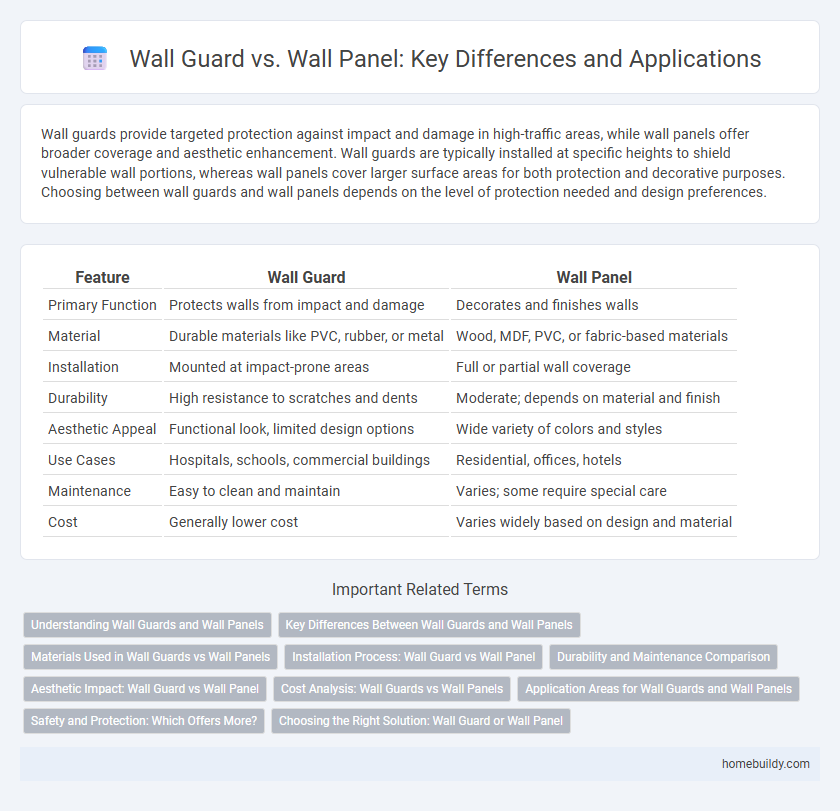Wall guards provide targeted protection against impact and damage in high-traffic areas, while wall panels offer broader coverage and aesthetic enhancement. Wall guards are typically installed at specific heights to shield vulnerable wall portions, whereas wall panels cover larger surface areas for both protection and decorative purposes. Choosing between wall guards and wall panels depends on the level of protection needed and design preferences.
Table of Comparison
| Feature | Wall Guard | Wall Panel |
|---|---|---|
| Primary Function | Protects walls from impact and damage | Decorates and finishes walls |
| Material | Durable materials like PVC, rubber, or metal | Wood, MDF, PVC, or fabric-based materials |
| Installation | Mounted at impact-prone areas | Full or partial wall coverage |
| Durability | High resistance to scratches and dents | Moderate; depends on material and finish |
| Aesthetic Appeal | Functional look, limited design options | Wide variety of colors and styles |
| Use Cases | Hospitals, schools, commercial buildings | Residential, offices, hotels |
| Maintenance | Easy to clean and maintain | Varies; some require special care |
| Cost | Generally lower cost | Varies widely based on design and material |
Understanding Wall Guards and Wall Panels
Wall guards are protective devices designed to shield walls from damage caused by impact, commonly used in high-traffic areas like hospitals and commercial buildings. Wall panels serve primarily aesthetic and functional purposes, providing decorative finishes and sometimes added insulation or soundproofing. Understanding the distinction helps in selecting the right product based on durability needs and design preferences, with wall guards emphasizing protection and wall panels focusing on appearance and surface enhancement.
Key Differences Between Wall Guards and Wall Panels
Wall guards are designed primarily to protect walls from impact and damage in high-traffic areas, typically made from durable materials such as rubber or vinyl. Wall panels serve a broader decorative and functional purpose, often used to enhance aesthetics, provide insulation, or improve acoustic performance, with materials ranging from wood to MDF and PVC. Key differences include their primary function--protection for wall guards versus design and utility for wall panels--and their installation environments, with guards common in commercial or healthcare settings and panels popular in residential or office interiors.
Materials Used in Wall Guards vs Wall Panels
Wall guards are typically constructed from durable materials like high-impact PVC, vinyl, or rubber to withstand daily wear and protect walls from damage in high-traffic areas. Wall panels, on the other hand, often utilize materials such as wood, MDF, laminate, or decorative composites designed primarily for aesthetic enhancement and insulation. The choice of materials in wall guards emphasizes resilience and impact absorption, whereas wall panels focus on versatility and visual appeal.
Installation Process: Wall Guard vs Wall Panel
Wall guards typically offer a simpler and faster installation process compared to wall panels, often requiring fewer tools and less preparation. Wall panel installation involves precise alignment, anchoring, and sometimes additional finishing steps, which can extend the project timeline. Choosing wall guards reduces labor costs and downtime, making them a practical option for high-traffic areas needing quick protection upgrades.
Durability and Maintenance Comparison
Wall guards offer superior durability compared to traditional wall panels, as they are specifically designed to withstand high-impact damage in commercial and healthcare environments. Their impact-resistant materials require minimal maintenance, often needing only routine cleaning without the risk of cracking or chipping. In contrast, wall panels tend to be more susceptible to dents and scratches, leading to frequent repairs and higher long-term maintenance costs.
Aesthetic Impact: Wall Guard vs Wall Panel
Wall guards provide a subtle protective layer that integrates seamlessly with interior designs, preserving wall aesthetics while preventing damage. Wall panels often serve as a prominent decorative feature, enhancing room character with varied textures and patterns but can dominate the visual space. Choosing between wall guards and wall panels depends on balancing functional protection with desired aesthetic impact in commercial or residential settings.
Cost Analysis: Wall Guards vs Wall Panels
Wall guards generally offer a lower initial cost compared to wall panels, making them a budget-friendly option for protecting high-traffic areas from impact damage. Wall panels, while more expensive upfront, provide broader wall coverage and can enhance aesthetic appeal, potentially reducing long-term maintenance expenses. Evaluating cost per square foot and factoring in durability, facility managers can determine the optimal balance between upfront investment and ongoing protection needs.
Application Areas for Wall Guards and Wall Panels
Wall guards are primarily used in high-traffic commercial spaces such as hospitals, schools, and airports to protect walls from impact damage and maintain cleanliness. Wall panels, offering broader design versatility, are commonly applied in both residential and commercial interiors for aesthetic enhancement and insulation purposes. While wall guards prioritize durability and protection, wall panels emphasize decorative appeal and environmental control.
Safety and Protection: Which Offers More?
Wall guards provide superior impact resistance by effectively absorbing shocks and preventing wall damage in high-traffic or industrial areas. Wall panels, while offering aesthetic appeal and basic protection, often lack the durability needed to withstand heavy impacts and abrasion. For environments prioritizing safety and protection, wall guards deliver enhanced defense against dents, scratches, and contamination, making them the preferred choice over standard wall panels.
Choosing the Right Solution: Wall Guard or Wall Panel
Wall guards provide targeted protection against impact damage in high-traffic areas, making them ideal for hospitals, schools, and commercial spaces where wall preservation is critical. Wall panels offer broader coverage with design flexibility, serving both protective and decorative purposes in residential or office environments. Selecting between wall guards and wall panels depends on the specific needs for durability, aesthetics, and the level of wall protection required.
Wall guard vs Wall panel Infographic

 homebuildy.com
homebuildy.com